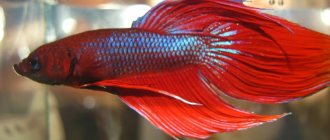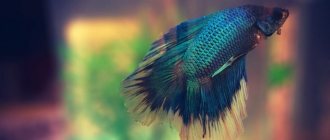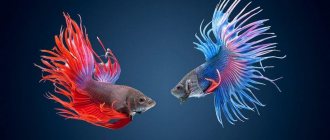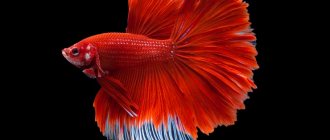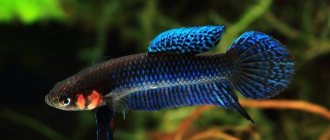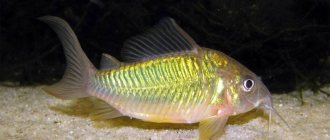How long does a betta fish live?
The cockerel is the most beautiful of all aquarium fish.
It was the character of this fish that influenced its name. During fights, apparently wanting to intimidate its opponent, the cockerel changes its color to a brighter one. Spawning affects the color of the fish in the same way. The diversity of the betta's fins is no less impressive. The classification of fish occurs both according to their shape and body color, which actually distinguishes them from their wild relatives.
Cockerel fish - types
If you look at the color of the fish, there are single-colored white and black specimens, blue and purple, yellow and red. Two-colored cockerels look more colorful, in which the tail has a different color from the rest of the body.
The multi-colored fish are impressive. The transition of colors from light to dark tones and vice versa can occur in different parts of the body. Dragon betta fish stay apart. Significantly larger than others, they have a body with a metallic sheen in the form of chain mail. Having looked closely at the fins of the cockerel in a straightened form, the breeders divided the fish into species: crescent, rosetail, round-tailed fish, brush-tailed cockerel, veiled, delta-tailed, flag-tailed, crown-tailed, double-tailed, poster, giant and other species, including the non-aggressive dwarf.
How long does a betta fish live?
How long a betta aquarium fish live largely depends on the owner of the aquarium. Labyrinth fish are very sensitive to their conditions. In an aquarium, even under normal conditions, a cockerel usually does not live to reach the 3-4 years of life allotted by nature. And you, in a desperate state, have to watch your beloved betta fish die.
Rare water changes, overfeeding and overcrowding of the reservoir greatly reduce the lifespan of fish. In addition to these factors, dense vegetation plays an important role with indispensable access to the surface for a breath of fresh air and maintaining the water temperature in the range from 26°C to 28°C.
It is not recommended to keep more than one male with females. But, if volume allows, the number of boys is increased to two. Although, cockerels with luxurious fins still feel better in small aquariums. Since it has been proven that the thickness of the water greatly influences their development.
How long a betta aquarium fish lives, oddly enough, depends on the factors influencing its behavior. An aggressive character constantly requires a fight. This situation can be resolved using a mirror or a glass partition between the males.
The rapid development of fish is embedded in its genes. Unlike other living beings, it is their mature age that gives their appearance the greatest beauty and charm.
WomanAdvice.ru>
Feed selection
Feed your pet different types of food, because the more varied the diet of an aquarium rooster, the longer the fish will live. But don't feed multiple types of food at one time. Do not feed your betta dry food mixed with frozen or live food.
Alive
Useful in live form:
The most accessible live food is bloodworms. Make sure the food is fresh and bright red in color. If you serve untreated insects and crustaceans, there is a high probability of introducing infection and parasites. Treat live food in a solution of methylene blue (30–40 drops per 100 ml of water) for 15 minutes or in a light pink solution of potassium permanganate. Rinse, after which you can feed the inhabitants of the aquarium. Another convenient and effective processing method is freezing.
Vegetable dishes
Sometimes feed your aquarium pets:
Before serving, scald with boiling water and finely chop the food, remove the peel if necessary. Sometimes the need for plants is met with dry food with herbal supplements. You need 5-8% fiber in your diet.
Granules
There are special granules with a balanced composition on sale. May be the main diet. Please read the ingredients before purchasing. Make sure the protein content is at least 40%.
Flakes
Thin multi-colored plates are found in all pet stores. The flakes act as an addition to the fish's diet; do not feed your bettas this food often. Vitaminized formulations are suitable for cockerels. Flakes are not suitable for golden and tropical fish. Do not take cereal by weight; the expiration date and composition must be indicated on the packaging. Do not feed your pets expired food, even if it looks fine. Store the cereal in a dry place, away from moisture.
Dry
Another option for the basis of the diet. There are universal foods for different types of fish and those designed specifically for bettas. Feed dry food to your bettas with caution, as it swells in the fish's stomach and, if overfed, causes breathing and swim bladder problems.
Frozen food
Frozen food is sold as an alternative to live food. It doesn't need to be defrosted. Dangerous if subjected to secondary freezing, stored under inappropriate conditions, or containing low-quality live food. In addition to frozen insects, feed your bettas finely chopped shrimp and lean fish fillets. The best option is homemade “freezing”.
Vitamins
With a nutritious diet, vitamins are not required. Vitamins help calm bettas when moving or supplement their diet with necessary substances.
How many times can you not feed aquarium fish?
Any pets - be they cats, hamsters, parrots or aquarium fish - involuntarily tie their owners to the house. After all, they need constant care - feeding, treatment, affection, etc. Therefore, every time when owners have to leave the house for some reason, even just for a few days, many fall into a real panic - who will take care of their pets?
Of course, aquarists are no exception. They are also very concerned about how long they can go without feeding the fish. After all, no one wants to return home and see their pets floating belly up.
It is quite difficult to answer this question unequivocally.
The fact is that different fish have different food needs. The more active they are, the more often and more densely they need to eat.
For example, barbs - those little comets in the aquarium - need to eat more often and get more calories. A leisurely cockerel or catfish needs much less food. It also depends on the fatness of the fish. If they are overweight (yes, this happens to fish just like any other animal), then they will be able to survive longer. But in any case, if you need to leave home for five to seven days, you don't have to worry about your pets.
If you have fish that lead a very quiet, inconspicuous and unhurried lifestyle, then they can easily last a couple of weeks.
True, after returning it is better not to feed them dry food, preferring live food. In general, after a diet, you should gradually increase the portions so that the fish do not overeat.
Of course, the ideal solution to this problem would be to ask your neighbors to help out - tell them what and how many times to feed the aquarium fish, explain when to turn the lights on and off, and calmly go about your business. But if this is not possible, you can simply feed the fish more closely, turn on the compressor and leave the house. However, this only applies to adult fish.
The fry, alas, are not able to survive even five days without food. Therefore, you should plan your trips carefully so as not to risk the health and life of your pets.
8lap.ru>
What affects the lifespan of a fish?
First of all, life expectancy is affected by the cleanliness of the aquarium. It is also important to remember that bettas love space. There should be at least 3 liters of water per individual. The following factors also have a direct impact:
- Situation. Place pets only in a pre-prepared tank. Otherwise, they will only live a couple of days and simply die. Be sure to plant living plants, they will produce oxygen. If the fish are left without food, they will be able to snack on algae.
- Neighborhood. Pets will live longer if they have the right neighbors. Here we need to take into account the compatibility of phenotypes.
- Nutrition. Bettas will eat any food. Remember, nutrition should be varied and regular. Don't feed too much. This can lead to pet overeating or water contamination.
- Aquarium volume. These fish are incredibly active. They will feel uncomfortable in a small tank. The betta needs enough space to swim.
- Equipment. Be sure to place a filter and a heater in the aquarium. The water must be constantly clean and at the correct temperature.
- Water temperature. Cockerels are cold-blooded creatures. Water temperature has a direct impact on a pet's lifespan. The fish will feel good in water whose temperature ranges from + 26... + 29˚С.
- Refusal to spawn. Individuals are quite calm about their own offspring. However, the lack of spawning negatively affects their lifespan. It is necessary to select a pair in a timely manner and provide them with suitable conditions for reproduction.
- Selecting an aquarium fish. When selecting a pet, you need to pay special attention to its appearance and behavior. The individual must be quite active, beautiful, and energetic. The indicators indicate good health of the species.
Basic principles of proper fish feeding
When choosing food for aquarium fish, you should understand that along with it it receives all the vitamins and microelements it needs, and their deficiency can adversely affect its general condition and immunity in general. Therefore, when choosing fish food, you should pay attention to the following parameters:
- manufacturer and quality;
- specific purpose;
- composition of microelements and vitamins;
- type of food (bottom or floating).
You should also know that an open can of food can be stored for no more than 6 months, then the food begins to deteriorate and the fish may stop eating it.
There are basic rules for proper feeding of aquarium fish:
- “hungry fish is healthy fish,” that is, the fish does not need to be overfed;
- fish do not know the feeling of satiety, so you need to calculate the daily norm yourself;
- It is better to feed the fish two small portions, morning and evening, than one large portion at a time;
- food should be varied, for example, alternating dry and live food;
- There is no need to feed the fish immediately after a complete or partial water change, as it may be stressed and will not be up to it.
As a result, we can say that a fish’s appetite is one of the indicators of its health, as well as the quality of its environment. If you notice an unhealthy specimen, it must be urgently placed in a separate aquarium and not fed for 1-2 days. If symptoms of the disease appear on it, then it is necessary to urgently begin treatment with the help of all kinds of medications or traditional methods.
Errors
Common mistakes made by aquarists:
It happens that the cockerel does not react to the food or spits it out. Reasons for refusing food:
Recommendations
Previous
Varieties of Frontosa: maintenance, types (Burundi, Kavala), care, feeding, compatibility, reproduction, reviews, diseases
Next
Varieties of Aquarium catfish (fish in an aquarium): types (varieties), names, maintenance, care, reproduction, what to feed
Great article 0

